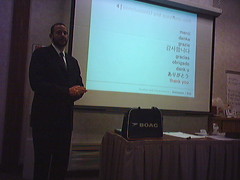I sincerely think human-centered designers’ (I use the term designer in the widest sense) ability to regard problems in a personal way results in drastically different solutions. Lately I’ve been looking at how marketing programs are designed to fit customers’ mental models, or not.
For example, here’s JetBlue’s frequent flier program: short flights earn 2 points, medium flights earn 4 points, and long flights earn 6 points. Book online and you get double points. 100 points earns you a free flight.
Compare this to the American Express rewards program, where I just scrolled through pages of Terms and Conditions text. The eligibility section has five paragraphs, here’s the first paragraph (that last sentence kills me):
The program is available to Basic Personal Card, Gold Card, American Express® Preferred Rewards Green Card, American Express® Preferred Rewards Gold Card, Platinum Card,® Rewards Plus Gold Card, FSA Gold Card, Fidelity American Express® Card, Fidelity American Express® Gold Card, Fidelity American Express Platinum Card® and some Blue from American Express Cards, Basic Optima,® Optima Platinum, Optima Gold Card or Business Management Account members whose American Express® Credit Card or Optima Card account is associated with an eligible AMEX charge Card account enrolled in the program (“Eligible Amex Credit Cardâ€). Basic and Additional CMs holding a Business Card from OPEN: The Small Business Network (“Business CMsâ€) who have one of the following Cards may also enroll in the program: Business Gold Card, Business Platinum Card,® Business Centurion® Card, Executive Business Card, Business Purchase Account, Business Costco Card or Business Membership Rewards Card. American Express® Rewards Green CMs and American Express® Rewards Gold CMs may also enroll and remain enrolled in the program as long as they have another eligible AMEX charge Card account enrolled in the program. Basic and Additional Corporate CMs may enroll in the program unless their company has chosen not to participate in the program. Accounts or Cards not listed in this paragraph (e.g., Student Optima Card, American Express® Credit Card for Students, American Express Costco Cash Rebate Card, Hilton HHonors Credit Card, Delta SkyMiles® Credit Card, Starwood Preferred Guest ® Credit Card, IN:NYCsm, Incentive Funds Cardtm, Golf Card, American Express® Cash Rebate Card, Blue Cash from American Express, Corporate Purchasing Card, Corporate Meeting Card, Corporate Defined Expense Card, Business Travel Accounts, line of credit accounts, Delta SkyMiles Business Credit Card, Gold Delta SkyMiles Business Credit Card, Platinum Delta SkyMiles Business Credit Card, Community Business Card, Business Cash Rebate Card, Cardless Central Billing Accounts and other non-Card accounts) are not eligible for enrollment in the program. Card eligibility is subject to change.

 More from
More from  More from
More from 